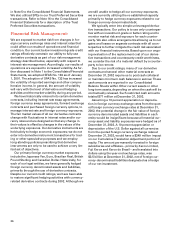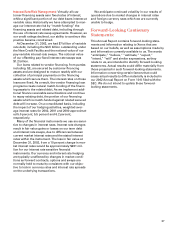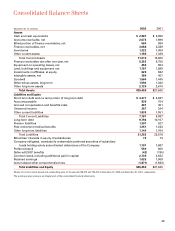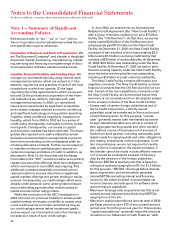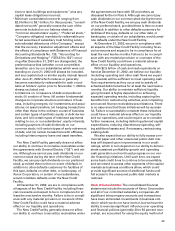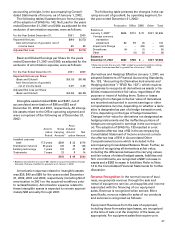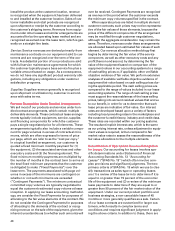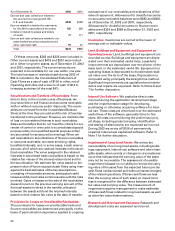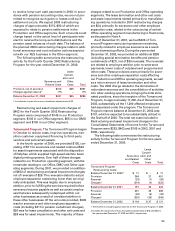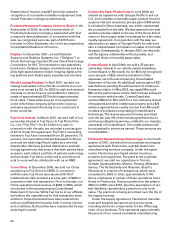Xerox 2002 Annual Report Download - page 48
Download and view the complete annual report
Please find page 48 of the 2002 Xerox annual report below. You can navigate through the pages in the report by either clicking on the pages listed below, or by using the keyword search tool below to find specific information within the annual report.
46
to Other expenses, net of $63 and an increase to
Income taxes of $25, from amounts previously report-
ed, for the year ended December 31, 2001.
Impairment or Disposal of Long-Lived Assets: In 2001,
the FASB issued Statement of Financial Accounting
Standards No. 144, “Accounting for the Impairment
or Disposal of Long-Lived Assets” (“SFAS No. 144”).
SFAS No. 144 retains the previously existing account-
ing requirements related to the recognition and meas-
urement of the impairment of long-lived assets to be
held and used, while expanding the measurement
requirements of long-lived assets to be disposed of
by sale to include discontinued operations. It also
expands on the previously existing reporting require-
ments for discontinued operations to include a
component of an entity that either has been disposed
of or is classified as held for sale. We adopted SFAS
No. 144 on January 1, 2002. The adoption of this stan-
dard did not have a material effect on our financial
position or results of operations.
Asset Retirement Obligations: In 2001, the FASB
issued Statement of Financial Accounting Standards
No. 143, “Accounting for Asset Retirement
Obligations” (“SFAS No. 143”). This statement
addresses financial accounting and reporting for obli-
gations associated with the retirement of tangible
long-lived assets and associated asset retirement
costs. We will adopt SFAS No. 143 on January 1, 2003
and do not expect this standard to have any effect on
our financial position or results of operations.
Business Combinations: In 2001, the FASB issued
Statement of Financial Accounting Standards No. 141,
“Business Combinations” (“SFAS No. 141”), which
requires the use of the purchase method of account-
ing for business combinations and prohibits the use
of the pooling of interests method. We have not his-
torically engaged in transactions that qualify for the
use of the pooling of interests method and therefore,
this aspect of the new standard will not have an
impact on our financial results. SFAS No. 141 also
changes the definition of intangible assets acquired in
a purchase business combination, providing specific
criteria for the initial recognition and measurement of
intangible assets apart from goodwill. As a result, the
purchase price allocation of future business combina-
tions may be different than the allocation that would
have resulted under the previous rules. SFAS No. 141
also requires that upon adoption of Statement of
Financial Accounting Standards No. 142 “Goodwill
and Other Intangible Assets” (“SFAS No. 142”), we
reclassify the carrying amounts of certain intangible
assets into or out of goodwill, based on certain crite-
ria. Upon adoption of SFAS No. 142, we reclassified
$61 of intangible assets related to acquired workforce
to goodwill that was required by this standard.
Goodwill and Other Intangible Assets: Goodwill repre-
sents the cost of acquired businesses in excess of the
fair value of identifiable tangible and intangible net
assets purchased, and prior to 2002 was amortized on
a straight-line basis over periods ranging from 5 to 40
years. Other intangible assets represent the fair value
of identifiable intangible assets acquired in purchase
business combinations and include an acquired cus-
tomer base, distribution network, technology and
trademarks. Intangible assets are amortized on a
straight-line basis over periods ranging from 7 to 25
years. We adopted SFAS No. 142 on January 1, 2002
and as a result, goodwill is no longer amortized.
SFAS No. 142 addresses financial accounting and
reporting for acquired goodwill and other intangible
assets subsequent to their initial recognition. This
statement recognizes that goodwill has an indefinite
life and will no longer be subject to periodic amortiza-
tion. However, goodwill is to be tested at least annual-
ly for impairment, using a fair value methodology, in
lieu of amortization. The provisions of this standard
also required that amortization of goodwill related to
equity investments be discontinued, and that these
goodwill amounts continue to be evaluated for
impairment in accordance with Accounting Principles
Board Opinion No. 18 “The Equity Method of
Accounting for Investments in Common Stock.”
SFAS No. 142 also requires performance of annual
and transitional impairment tests on goodwill using a
two-step approach. The first step is to identify a poten-
tial impairment and the second step is to measure the
amount of any impairment loss. The first step requires
a comparison of the carrying value of reporting units,
as defined, to the fair value of these units. The
standard requires that if a reporting unit’s fair value is
below its carrying value, a potential goodwill impair-
ment exists and we would be required to complete the
second step of the transitional impairment test to
quantify the amount of the potential goodwill impair-
ment charge. Based on the results of the first step
of the transitional impairment test, we identified
potential goodwill impairments in the reporting units
included in our Developing Markets Operations
(“DMO”) operating segment. We subsequently com-
pleted the second step of the transitional goodwill
impairment test, which required us to estimate the
implied fair value of goodwill for each DMO reporting
unit by allocating the fair value of each reporting unit
to all of the reporting unit’s assets and liabilities. The
fair value of the reporting units giving rise to the tran-
sitional impairment loss was estimated using the
present value of future expected cash flows. Because
the carrying amount of each reporting unit’s assets
and liabilities (excluding goodwill) exceeded the fair
value of each reporting unit, we recorded a goodwill
impairment charge of $63. This non-cash charge
was recorded as a cumulative effect of change in


